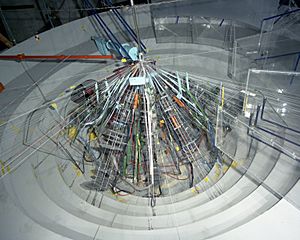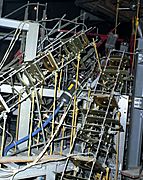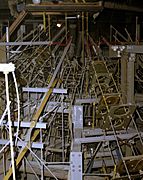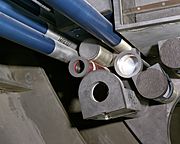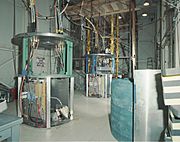Operation Cornerstone facts for kids
Quick facts for kids Cornerstone |
|
|---|---|
| Information | |
| Country | United States |
| Period | 1988–1989 |
| Number of tests | 11 |
| Test type | underground shaft, tunnel |
| Max. yield | 150 kilotonnes of TNT (630 TJ) |
The Cornerstone nuclear test series was a group of 11 nuclear tests carried out by the United States between 1988 and 1989. These tests happened after the Operation Touchstone series and before the Operation Aqueduct series. Nuclear tests are experiments where scientists explode nuclear devices, usually underground, to study their effects or to improve nuclear weapons.
Contents
What Was the Cornerstone Series?
The Cornerstone series included 11 underground nuclear tests. These tests were done to help develop new nuclear weapons and to perform safety experiments. The tests took place at the Nevada Test Site, a special area in Nevada where such experiments are conducted.
Key Facts About the Tests
The tests in the Cornerstone series varied in their power, which is called yield. The smallest tests had a yield of "less than 20 kilotons" (kt), while the largest test, named Dalhart, had a yield of 150 kilotons. A kiloton is a measure of explosive power equal to 1,000 tons of TNT. To give you an idea, the atomic bomb dropped on Hiroshima in 1945 had a yield of about 15 kilotons.
Most of these tests were done in deep holes called shafts. One test, Misty Echo, was done in a tunnel. Some tests happened at the exact same time in different holes, or even in the same hole at different depths.
Important Tests in the Series
- Dalhart: This was the most powerful test in the series, with a yield of 150 kilotons. It happened on October 13, 1988.
- Misty Echo: This test, with a yield of 25 kilotons, took place on December 10, 1988. It was special because it was conducted in a tunnel. Scientists also detected some venting during this test, which means a small amount of radioactive gas escaped into the atmosphere.
- Kawich Tests: There were several "Kawich" tests (Blue, White, Black, Red). These were often safety experiments, meaning they were designed to see how nuclear devices would behave under different conditions, not just to develop new weapons. Some of these tests also had small amounts of venting.
- Palisade: This test involved three separate explosions happening at the same time in the same hole on May 15, 1989. These were for both weapons development and safety experiments.
Gallery


